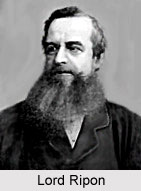 Ripon`s viceroyalty witnessed the relaxation of governance in every field. Ripons` Resolution of 1882 surpasses as a milestone in the growth of local self-government. The government of Ripon noticed with gratification that a huge income from local rates and cesses had been insured and in some provinces the administration of this income had been generously assigned to local bodies and that municipalities had amplified in number and worth. It was also sensed that there was a bigger dissimilarity of progress in various parts of the country than diverging local situations seemed to guarantee, that many services honestly altered for `watch and ward` (police maintenance), were a great load on the reserve of the municipalities. Ripon`s government preferred the provincial government to implement similar principles of financial decentralisation which Lord Mayo`s government did on the local bodies. The regional governments were asked to embark on a vigilant study of provincial, local and municipal finances with a view to determine -
Ripon`s viceroyalty witnessed the relaxation of governance in every field. Ripons` Resolution of 1882 surpasses as a milestone in the growth of local self-government. The government of Ripon noticed with gratification that a huge income from local rates and cesses had been insured and in some provinces the administration of this income had been generously assigned to local bodies and that municipalities had amplified in number and worth. It was also sensed that there was a bigger dissimilarity of progress in various parts of the country than diverging local situations seemed to guarantee, that many services honestly altered for `watch and ward` (police maintenance), were a great load on the reserve of the municipalities. Ripon`s government preferred the provincial government to implement similar principles of financial decentralisation which Lord Mayo`s government did on the local bodies. The regional governments were asked to embark on a vigilant study of provincial, local and municipal finances with a view to determine -
a. What details of receipt and charge could be reassigned from regional to local heads for governance;
b. What re-distribution of particulars were worthy, with the objective of laying stress on local and municipal bodies, those which were best realised and apprehended by the people; and
c. To conceive methods of equalising local and municipal tax revenue all through the empire.
The imperial Government borrowed the resolution of 1882, which depicts the efficient starting of local self-government in India. The growth of local bodies was promoted not only with the perspective to develop the administration, but also as a tool of political and admired education. Local boards were to be built up throughout the country and assigned with specific duties and entrusted with appropriate resources of revenue. These local bodies were proposed to possess non-official majorities, together with general system of election, wherever local conditions allowed. Official intervention was proposed to be cut down to bare minimum and exerted to modify and check the moves of local bodies, but never to order policies. Official executive permission was however essential in certain cases, like levying loans, alienation of municipal property, infliction of new taxes, attempting works costing more than an ordained sum, setting up rules and bye-laws etc.
In pursuit of this Resolution several Acts were passed between 1883 and 1885, that immensely modified the constitution, powers and functions of municipal bodies in India. But the bureaucracy did not share the moderate views of the Viceroy and thought that the Indians were sub-standards for self-government.



















